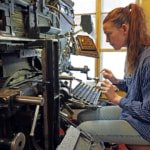Funding accorded to the Press Museum Fjeld-Ljom in Norway
The Council of Europe and the European Commission have granted the Pressemuseet Fjeld-Ljoms Venner (Friends association of the Press Museum Fjeld-Ljom) a grant of 9,900 euros for training in the use and maintenance of typesetting machines. The project has a European perspective, and invitations to gatherings around the line casting machines in Fjeld-Ljom have now gone out to enthusiasts throughout Europe. The funds are to be used as scholarships and travel grants for those who otherwise not would have had the opportunity to participate in the gatherings.
European heritage days is an annual celebration of cultural heritage, with events all over Europe. In Norway, the Kulturminnedagene is organized under this common umbrella, and the Pressemuseet Fjeld-Ljoms Venner has in recent years held events with open days in the newspaper house and lectures related to the heritage days.
Annually, on a European basis, funds are distributed to ten different cultural heritage measures, on the basis of an extensive search and selection process. Twenty applicants take part in the final round, where you have to give a careful account of the planned measures, with a budget and implementation plan.
– It is a narrow needle’s eye to get through, and as far as I know, such funds have only been given once before to a project in Norway, says chairman of the Pressemuseet Fjeld-Ljoms Venner, Jan Erik Øvergård.
Enthusiasts
Typesetting machines of the brands Linotype and Intertype were throughout most of the 20th century used in virtually all newspapers across most of Europe. The machines went out of regular production in the 1970s and no longer have any commercial application. They can be found in quite a few museums, but the challenge is expertise in use and maintenance. Most of those who master the machines are now retired.
So also in the friends association in Røros, where the initiative for various recruitment and training measures has been taken in recent years, to ensure continuity in the competence on the machines.
– Working with these machines is suitable for enthusiasts who are willing to spend a lot of their free time maintaining specialist skills that are quite unique. This is a central part of our newspaper and printing history, which we have in common with the whole of Europe, and therefore it was natural to apply for funds from European heritage days. The grant we have received is of course financially important for us, we do not receive any direct support for this work from the owner of the house and collections, the local Rørosmuseet, but equally important is the recognition that the grant gives from central cultural heritage preservation in Europe, says Øvergård.
– The fact that we get this encouragement in our work from the EU, we hope means that we also nationally and not least locally here in Røros get a few more eyes open to the importance of the work we do in the Press Museum.
Three training sessions
The plan is to have three training sessions for interested professionals from Europe, both those who possess expertise and new, preferably younger recruits who are interested in learning how to master the typesetting machines. The sessions will be held in connection with already planned works in the Press Museum Fjeld-Ljom, and possibly a session will be held in another museum more centrally in Europe.
– The number of skilled typesetting experts is not that big, so it is natural to see Europe as one. We don’t have much more than a handful of enthusiasts who master such machines now, and it is urgent to spread the expertise and train a few more, so that in the future we can also show the machines in active use, and not just as dead objects, says Øvergård.
The Pressemuseet Fjeld-Ljoms Venner prints a museum newspaper every autumn, and for the production of this newspaper, working line casting machines are absolutely necessary.
For more information about EHD:
https://www.europeanheritagedays.com/

Ane Thon Knutsen at the Linotype typesetting machine that was used in the production of the newspaper Fjell-Ljom until 1975. This image now fronts all ten cultural conservation measures that this year have been allocated funds from the Council of Europe and the European Commission. Photo: Jan Erik Øvergård, Pressemuseet Fjeld-Ljoms Venner.